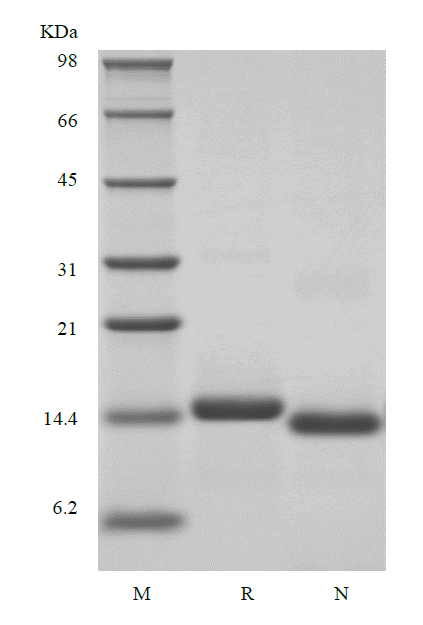- Synonyms
- Neurotrophin-5, NT-5
- Source
- Escherichia coli.
- Molecular Weight
- Approximately 28.1 kDa, a noncovalently linked homodimer of two 14.0 kDa polypeptide monomers (262 total amino acid residues).
- AA Sequence
- MGVSETAPAS RRGELAVCDA VSGWVTDRRT AVDLRGREVE VLGEVPAAGG SPLRQYFFET RCKADNAEEG GPGAGGGGCR GVDRRHWVSE CKAKQSYVRA LTADAQGRVG WRWIRIDTAC VCTLLSRTGR A
- Purity
- > 97 % by SDS-PAGE and HPLC analyses.
- Biological Activity
- Fully biologically active when compared to standard. The ED50 as determined by the dose-dependent induction of choline acetyl transferase activity in rat basal forebrain primary septal cell cultures is less than 50 ng/ml, corresponding to a specific activity of > 2.0 × 104 IU/mg.
- Physical Appearance
- Sterile Filtered White lyophilized (freeze-dried) powder.
- Formulation
- Lyophilized from a 0.2 μm filtered concentrated solution in PBS, pH 5.5.
- Endotoxin
- Less than 1 EU/μg of rHuNT-4 as determined by LAL method.
- Reconstitution
- We recommend that this vial be briefly centrifuged prior to opening to bring the contents to the bottom. Reconstitute in sterile distilled water or aqueous buffer containing 0.1 % BSA to a concentration of 0.1-1.0 mg/mL. Stock solutions should be apportioned into working aliquots and stored at ≤ -20 °C. Further dilutions should be made in appropriate buffered solutions.
- Stability & Storage
- Use a manual defrost freezer and avoid repeated freeze-thaw cycles.
- 12 months from date of receipt, -20 to -70 °C as supplied.
- 1 month, 2 to 8 °C under sterile conditions after reconstitution.
- 3 months, -20 to -70 °C under sterile conditions after reconstitution.
- Usage
- This material is offered by Shanghai PrimeGene Bio-Tech for research, laboratory or further evaluation purposes. NOT FOR HUMAN USE.
- SDS-PAGE

- Reference
- 1. Gao WQ, Zheng JL, Karihaloo M. 1995. J Neurosci, 15: 2656-67.
2. Ogborn DIandGardiner PF. 2010. Muscle Nerve, 41: 385-91.
3. Peinado-Ramon P, Salvador M, Villegas-Perez MP, et al. 1996. Invest Ophthalmol Vis Sci, 37: 489-500.
4. Yuen ECandMobley WC. 1999. Exp Neurol, 159: 297-308.
5. Sakuma K, Watanabe K, Sano M, et al. 2001. Brain Res, 907: 1-19.
- Background
- NT-4 also named as NT-5 is a neuronal and epithelial grow factor belongs to the NGF-beta family. The NT-4 precursor is consisted of a 24 a.a. signal peptide, a 56 a.a. propertied and 130 a.a. NT-4. The mature protein has six Cys amino acid residues and has the relative structure with NT-3, BDNF (sharing about 48 % - 52 % sequence identity). Additionally, it shares 91 % and 95 % a.a. sequence identity with mouse and rat NT-4. NT-4 is mainly expressed in prostate and has low level thymus, placenta, and skeletal muscle. It can binding with the LNGFR and trkB receptors and plays a crucial role in the regulation of survival and the maintenance of peripheral sensory sympathetic neurons. Defect of NT-4 may cause primary open angle glaucoma type 1O.







 COA申请
COA申请
